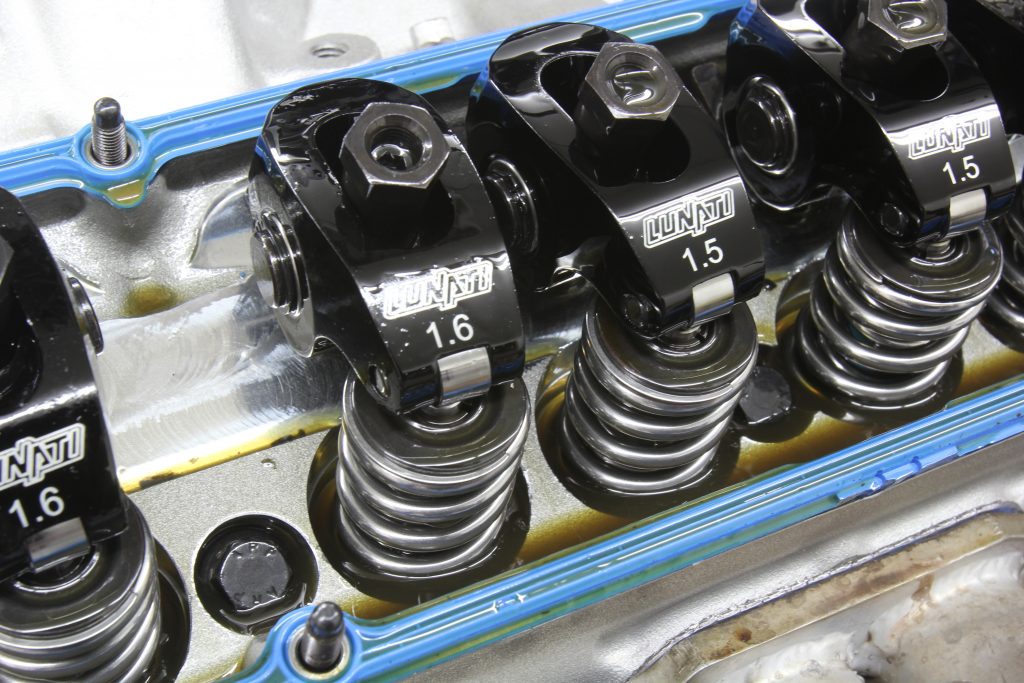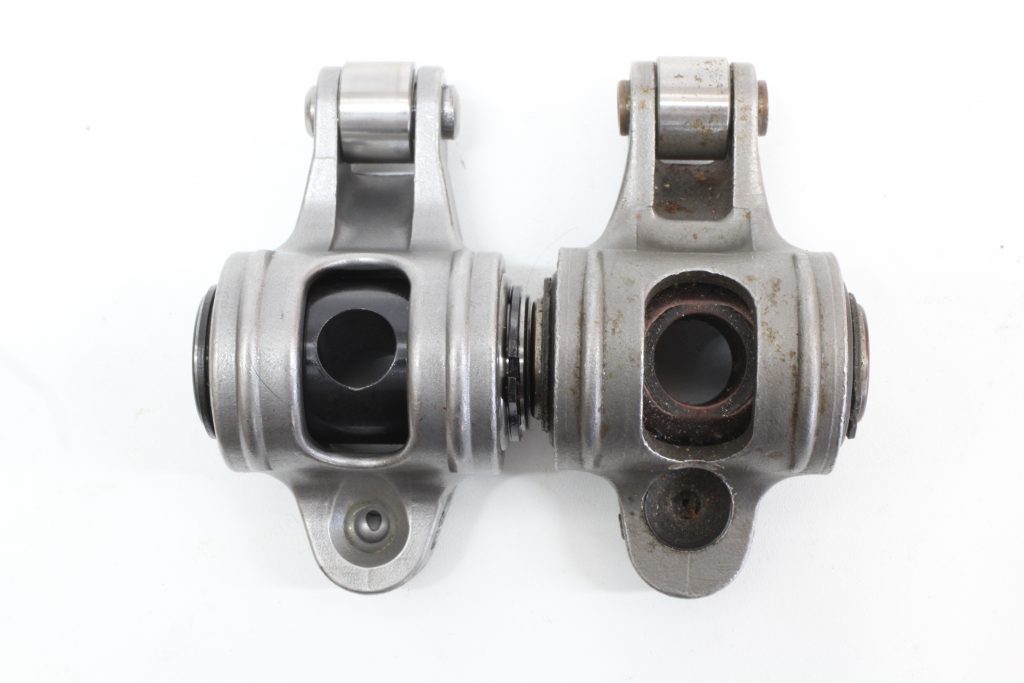Why do some engine builders stagger the rocker arms, 1.6 on the intake and 1.5 on the exhaust? Is there any benefit in doing that?
G.L.
This is a great question and deserving of another typical Ask Away long answer. Let’s start by defining rocker ratio for those who may not understand the term.
Understanding Rocker Arm Ratio
Most internal combustion engines, whether a pushrod or an overhead cam design, will employ a rocker arm. For the sake of this discussion, we’ll focus on a typical pushrod V8 engine and we’ll use a small block Chevy as our example. But throughout this discussion let it be known that everything here relates to any pushrod engine, not just our little small block Chevy.
The stock rocker ratio for the venerable small block is 1.5:1. This process begins when the rocker arm takes movement from the cam lobe through the lifter and pushrod to the pushrod side of the rocker arm. The rocker then multiplies the lift by a ratio of 1.5:1. To make things simple, let’s say that our intake lobe lift is 0.300-inch. This means that theoretically, we will have 0.300 x 1.5 = 0.450-inch of lift at the valve.
This ratio increase is created through simple leverage. If we use a typical aftermarket roller trunnion rocker arm as our example, if the distance from the pushrod cup centerline to the trunnion centerline (the rocker pivot point) is one inch, then the distance from trunnion centerline to the centerline of the roller tip will be 1.5 inches.
Notice we used the term “theoretically” when we mentioned ratio. We did this because the rocker arm scribes an arc as it moves through its lift curve. As it creates this arc, it is also moving laterally across the valve tip. This movement is roughly 0.040- to 0.080-inch. Because of this change in position on the valve tip, there is some point where the rocker ratio is 1.5:1 while at other lift positions the ratio might be higher at 1.51:1, or more likely, less than the stated ratio—perhaps at 1.48:1 or less.
We won’t go too deeply into this, but pushrod length has a direct effect on where the roller rocker arm tip contacts the valve. This means pushrod length is critical to properly setting up the valvetrain so that the rocker scribes a narrower path across the valve tip. A simple search through some of our Ask Away tech answers will show you how to properly position the rocker tip on the valve tip with pushrod length.
Rocker Arm Ratio & Valve Lift
So now we can address your actual question of why staggering ratios. Clearly, a simple way to increase valve lift would be to increase the rocker ratio. Let’s say we have a 0.500-inch valve lift hydraulic roller camshaft in our small block Chevy and we’ve just purchased new heads that increase airflow over the old heads up to 0.600-inch valve lift. This means we’re not taking full advantage of what the heads can deliver.
The smart choice is to change cams. But let’s say a new cam isn’t in the cards right now, but you do have access to a set of 1.6:1 roller rockers. By adding the higher ratio rocker arms, some simple math will let us know how much we can increase valve lift. With a 0.500-inch valve lift with 1.5:1 rockers, we can first determine (theoretically) our cam lobe lift by simply dividing 0.500 by 1.5 = 0.333-inch. Now when we multiply 0.333 x 1.6 = 0.533-inch, it’s our new valve lift with the higher ratio rockers. If we wanted to go to 1.7:1 rockers, the lift would increase to 0.566-inch—a sizable increase in valve lift.
Drawbacks of Increasing Rocker Arm Ratio
But as with all things in life and high performance engines, there is no free lunch. As the rocker ratio increases, it also accelerates the valve faster at any given engine speed. Think of it like changing from a 3.08:1 rear gear to more like a 4.10:1 rear gear in a car. The valves will now accelerate much quicker. As engine rpm increases, this means the valves are forced to accelerate quicker in order to reach that higher valve lift. This places much greater demands on the valve springs to keep up.
At near-peak engine speeds, this increased acceleration can overcome the valve spring’s ability to control the valve. This will create what is commonly called valve float. This is an all-encompassing term that really relates to the spring’s inability to keep the valve under control. We won’t go into a textbook-sized explanation on what’s going on here. Instead we’ll keep it simple and just say that the moment the valve spring loses control of the valve, the engine will begin to lose power.
On an engine dyno, we’ve seen engines go into valve float. When this occurs, power usually plummets immediately. The severity of this power loss is directly related to how badly the valves float. This loss of control is generally where the valve bounces off the seat at closing. In the case of a bouncing intake valve, this allows cylinder pressure to escape back up the intake port instead of contributing to making power.
Why Stagger Rocker Arm Ratios?
With regard to staggered ratios, the small block Chevy is a classic example. Many small block Chevy heads suffer from a less-than ideal exhaust port. One way to crutch this situation is with additional rocker ratio on the exhaust side. So with 1.5:1 rockers on the intake side, an engine builder might add a 1.6:1 ratio rocker on the exhaust side. We’ve seen this benefit many small-blocks. As an example, a stock iron small-block Vortec head can often benefit from adding a 1.6:1 rocker arm on the exhaust side. This potentially could improve power by 5 to 10 horsepower.
Potential Issues with Staggered Ratios
But there are obvious consequences as well. In the case of the stock iron Vortec head, there is a limited space between the valve guide seal and the bottom of the valve retainer. The stock iron Vortec heads limit valve lift to 0.450-inch or less. So if you want to increase the valve lift with a rocker ratio change, you need to first make sure the retainers will not hit the valve guide seals. This will probably require machine work to the heads. This is a simple process but will require the heads to be removed from the engine to accomplish this task.
We’ve also seen many times where short duration camshafts do not respond well to added rocker ratios because of weak springs. So basically if you are considering adding rocker ratio, it might be a good step first to determine how good your valve springs are before considering changing to a higher rocker ratio. Any cam company can help you with recommendations for valve springs based on your particular combination. For a typical flat tappet hydraulic cam in a small block Chevy, you are looking at seat pressures of around 105 to 110 pounds and open pressures around 290 to 300 pounds. These spring loads will help to control the valves at higher engine speeds. A hydraulic roller engine will need even stronger springs.
Other Things to Consider When Changing Rocker Ratios
Keep in mind that adding spring pressure will demand you use a high-zinc oil to make sure those flat tappets do not kill the cam or lifters. This additional valve spring load makes it harder on the lifters and the cam. As is typically the case, one change to your engine can have significant impact on the rest of the engine. So as you can see, there are many other issues to consider before swapping rocker ratios.



Did you ever finish the s10 tpi build the Stein truck. Also has anyone ever turned a ramjet 350?
Hello , mathematically speaking , as the value of the opening ratios change so does valve timing , overlap and the all important crossflow factor . Crossflow is the effect of outgoing exhaust gas helping to bring in a fresh intake charge for the next compression stroke . Using more timing and valve overlap tends to move the powerband upward on the RPM scale , usually conducive to a greater horsepower rating .
Technically, the valve timing won’t change, as the start of the lift, and the end of the close remain the same. However, cross flow and power will be affected as the valve will be open wider during its lift allowing for more flow. To have it stay open longer will require a different cam profile.
jeff,need your advice please,i am doing a complete redo of my 1968 SS camaro.i am thinking a stock crate ls376/430 or ls376/480 engine. (i worry about tuning problems with the ls376/480 engine.)i plan to use a new tremec TKX 5 speed transmission.i would like as much controllable power as possible and no drive ability issues.One,what are your thoughts on these or any other engines.Two, what are your thoughts on transmissions close ratio 1st.gear 2.87 vs.wide ratio 1st.gear 3.27.Note my rear gear ratio is 3.31 posi.trac.original to car. thanks
What is the advantage with long rocker arms on a small block Chevrolet crower number 73674? Are they Easter on cam and lifters? Do they make more power.
Hello Whitey I bet Jeff and the rest of us are pleased as punch that you clarified what Jeff failed to do.
Ask any experienced dyno operator about changing from 1.5 to 1.6 and they will tell you the increase in performance isn’t noticeable on the dyno. Valve lift isn’t much of a determining factor in the power output of anything other than an extremely powerful engine at very high rpm.
Jeff, you sure have come a long way from hanging out at Lindy’s Speed Shop